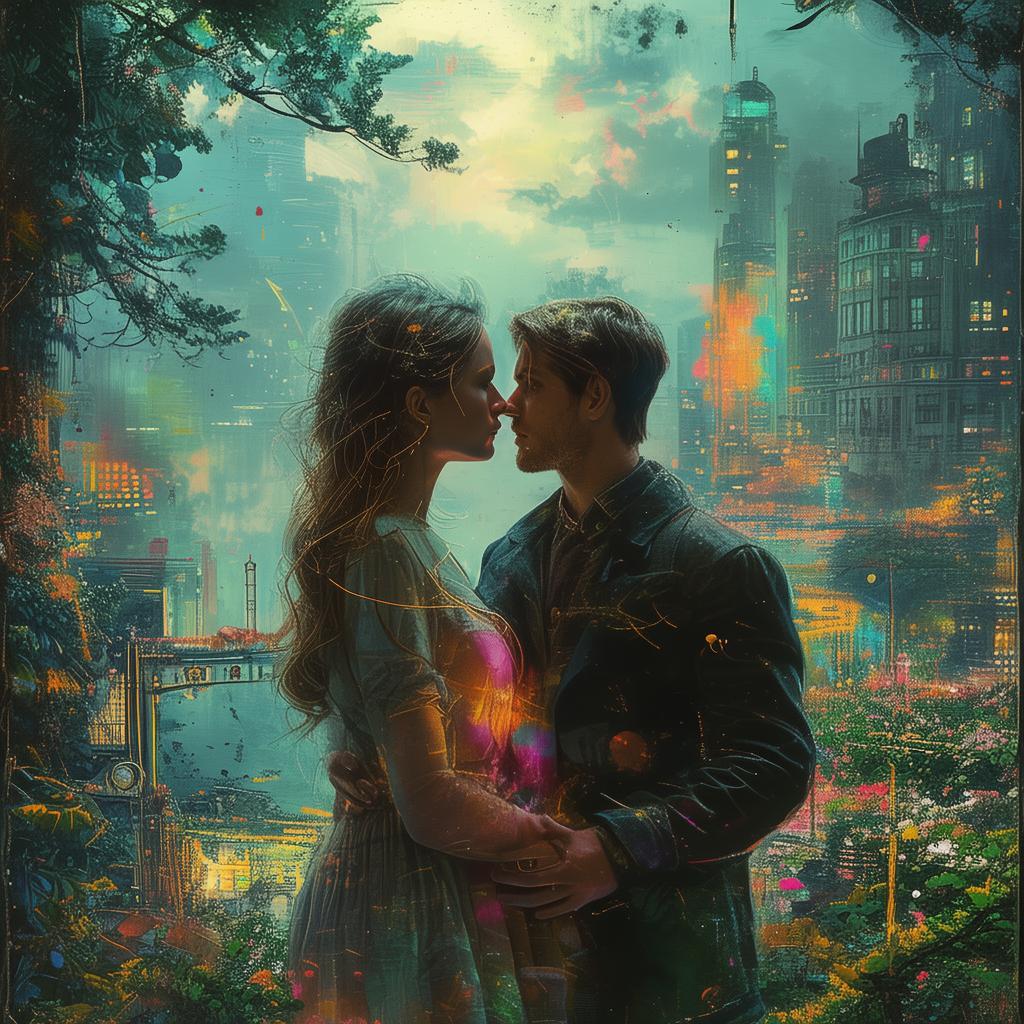Whispers of the Wuzhen Bridge

In the ancient town of Wuzhen, where time seems to stand still, there was a young artist named Lin. Her passion for painting was matched only by her insatiable curiosity about the world around her. She had spent countless hours by the Wuzhen Bridge, capturing its intricate details and the stories it seemed to hold in its weathered stone.
One crisp autumn morning, as Lin set up her easel, she felt an inexplicable urge to explore the bridge's less-traveled path. She wandered until she reached a small, secluded area that was shrouded in mystery. There, she found a weathered, old book half-buried in the dirt. The cover, adorned with intricate calligraphy, seemed to call out to her.
With trembling hands, Lin opened the book. Its pages were filled with sketches of the bridge and the surrounding countryside, but it was the last page that captured her attention. It was a painting of a young woman, standing on the bridge, her eyes reflecting a profound sadness. The artist had signed the painting, but the signature was faded, almost as if it were meant to be forgotten.
Lin's curiosity piqued, she began to read the book's text, which was a journal of sorts, chronicling the life of the young woman, who she later learned was named Mei. Mei had lived in Wuzhen a century before, and her story was one of love, betrayal, and the enduring power of the human spirit.
As Lin delved deeper into Mei's life, she found herself drawn to the young woman's passion for art and her unyielding determination to pursue her dreams. Mei had loved a man, but he had betrayed her, leaving her to face the world alone. Yet, Mei's love for her art had given her the strength to overcome her pain and continue living.
Lin was struck by the similarities between Mei and herself. She, too, had faced heartbreak and had struggled to find her place in the world. As she read on, she discovered that Mei had been a romantic philosopher, a rare breed of artist who believed that love and philosophy were inextricably linked.
Lin was fascinated by this idea and began to incorporate it into her own work. She started to explore the philosophical underpinnings of love in her paintings, using the Wuzhen Bridge as her canvas. Her work began to gain attention, and soon, she was known as the artist who painted with love and philosophy.
As Lin's fame grew, so did her understanding of love and life. She realized that love was not just about the heart, but also about the mind and the soul. It was a journey, a continuous search for meaning and purpose.
One evening, as Lin stood on the bridge, painting the sunset, she felt a presence behind her. She turned to see a young man, his eyes reflecting the same curiosity that had once filled hers. He introduced himself as Xiao, a historian who had come to Wuzhen to study its rich history.
The two struck up a conversation, and soon, they found themselves discussing the philosophical underpinnings of love. They discovered that they shared a similar vision of the world, and a deep connection formed between them.
Lin and Xiao's love was not one of fiery passion, but of quiet understanding and mutual respect. They would often walk together on the bridge, discussing art, philosophy, and life. It was on one of these walks that Xiao revealed his true identity. He was a descendant of Mei, and the book she had found was a family heirloom.
The revelation brought Lin and Xiao even closer together. They realized that their love was a continuation of Mei's legacy, a testament to the enduring power of love and philosophy. Together, they worked to preserve Mei's legacy, ensuring that her story would be told for generations to come.
Lin's paintings continued to evolve, reflecting the deep love and understanding she shared with Xiao. They became symbols of the bridge between past and present, of the connection between artists and their inspirations.
As the years passed, Lin and Xiao's love only grew stronger. They stood together on the Wuzhen Bridge, watching the sunset, their hands entwined, their hearts beating as one. The bridge, once a silent witness to Mei's story, had become a living symbol of their own love, a testament to the power of love and philosophy to transcend time and space.
In the end, Lin's love for Xiao and her philosophy of romantic philosophy became the foundation of her art. Her paintings were not just works of art, but love letters to the world, a celebration of the enduring power of love and the human spirit. And so, on the Wuzhen Bridge, where the past and present meet, the story of Lin and Xiao would be told, a story of love, philosophy, and the enduring power of the human heart.
✨ Original Statement ✨
All articles published on this website (including but not limited to text, images, videos, and other content) are original or authorized for reposting and are protected by relevant laws. Without the explicit written permission of this website, no individual or organization may copy, modify, repost, or use the content for commercial purposes.
If you need to quote or cooperate, please contact this site for authorization. We reserve the right to pursue legal responsibility for any unauthorized use.
Hereby declared.









